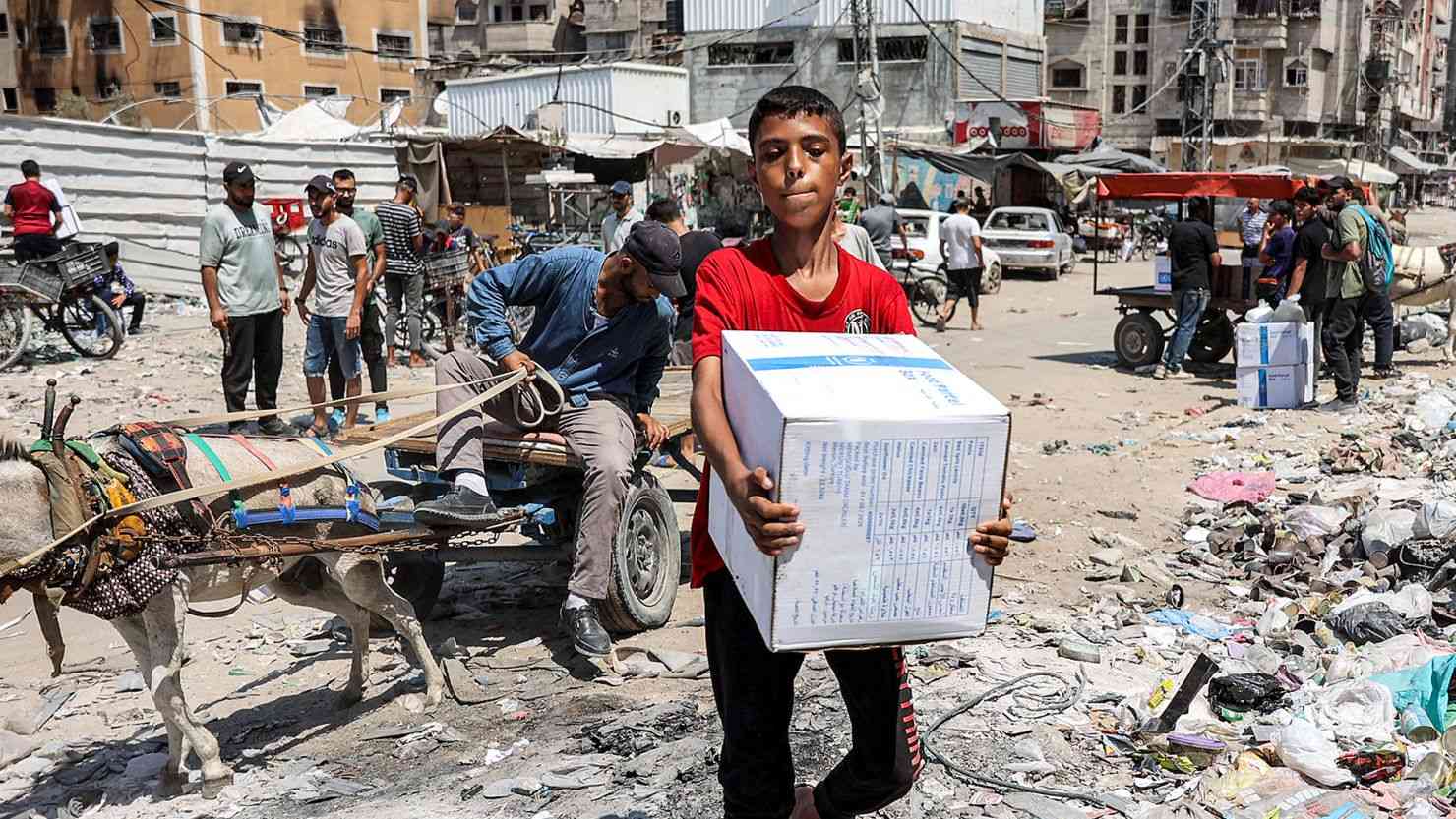
Why the UN agency for Palestinian refugees is so problematic?
Two new Israeli laws severely limit the operations of the United Nations Relief and Works Agency (UNRWA). One bans UNRWA from operating inside Israel; the other blocks Israeli officials from working with the agency.
World outcry has been swift. Both Belgium and Jordan issued official statements claiming Israel is violating international law by censuring UNRWA. Britain has threatened to stop arms sales to Israel. The Qatari-based news agency Al Jazeera, with 430 million customers worldwide, declared that Israel’s new laws are an act of “war".
A number of myths about UNRWA have been repeated by politicians, activists and journalists as facts. Here are 7 common myths about UNRWA, and the truth about this troubled organisation.
Myth: UNRWA aids Palestinian refugees
It’s common to hear the oft-repeated myth that UNRWA aids Palestinian refugees. UNRWA claims that “5.9 million refugees (are) covered by our protection mandate.” Yet UNRWA’s definition of “refugee” doesn’t match anyone else’s use of the term - including the United Nations itself.
Most refugees are aided by the UN High Commissioner for Refugees (UNHCR) which helps 117.3 million people. It aims to settle refugees in safety and security, often in third countries: “We…find long-term solutions. This can include support to voluntarily return to their home country once safe to do so, integration into the host community, or resettlement and integration in a third country.”
But there’s one group of people for whom “refugee” is defined very differently: Arabs who resided within the borders of Israel, Gaza, and the West Bank between June 1, 1946 and May 15, 1948. (May 15, 1948 saw Israel’s establishment and the subsequent rejection of a Palestinian state and invasion of Israel by its Arab neighbors in 1948.) Over 800 000 Jews were expelled from Arab countries, but they are not defined as refugees by UNRWA.
- HCC considers cancelling ZimPhos contract
- Zim hit by grain shortage
- Masvingo teen stars in human wildlife ‘Konflict’ film
- Artisanal miners bear brunt of TB infections
Keep Reading
UNRWA began functioning in May 1950 and abandoned traditional definitions of “refugee”. According to UNRWA, refugee status continues indefinitely, no matter where one was born or lives, no matter what one’s circumstances, so long as one is registered as Palestinian with its agency: “The descendants of Palestinian refugee males, including adopted children, are also eligible for registration.” Keeping people refugees, continuing their conflict with Israel, and not building new lives for the people it purports to help is UNRWA’s overarching goal. The number of Palestinian refugees registered with UNRWA has increased massively through the years, rising 780% since 1950.
UNRWA has turned this manufactured crisis of nearly 6 million “refugees” into a potent money-maker. While the UN High Commissioner for Refugees, which is responsible for a much larger and more beleaguered population of actual refugees, employs 20 300 staff around the world, UNRWA’s number of employees is over 30 000.
Myth: Palestinian refugees were forced from their homes by Israel.
UNRWA spends considerable effort propagating untruths about Israel’s establishment in 1948 and repeatedly refers to Israel’s continued existence as an “ongoing Nakba,” using the Arabic term for catastrophe.
Tragically, many of the historical accounts that UNRWA spreads and takes as fact are based on years of myths and exaggeration, rather than fact.
In 1948, as Arab armies attacked Israel, leading Arab politician Musa Alami recalls, the Arabs who lived in present-day Israel had no intention of living side by side with their Jewish neighbors, and welcomed the invasion of neighboring rab armies. “On May 14, 1948, crowds of Arabs stood by the roads leading to the frontiers of Palestine, enthusiastically welcoming the advancing armies.” As Israel slowly brought the armies of Egypt, Jordan, Syria, Iraq and Lebanon to defeat, Alami described, “the Arabs began to see the possibility of defeat. As the possibility turned into reality, the flight of the Arabs increased - more than 300,000 departed after May 15…”
Violence by Jews was hardly ever a factor in the flight of Muslims in the midst of Israel’s War of Independence. 700 000 Arabs were not forced from their homes by violent Jews, as UNRWA maintained. Yet you’d never know that from UNRWA’s statements, which describe the establishment of Israel as the scene of a massive spasm of violence and mass expulsion.
Truth is not much of a factor in UNRWA’s narrative. Israeli historian Eliezer Tauber, for instance, has documented how Arabic language radio stations in 1948 invented atrocities that Jews supposedly perpetrated on Arabs, in order to inflame passions and encourage Israel’s Arab neighbors to fight harder. He quotes Husayn Fakhri al-Khalidi, the Secretary of the Arab Higher Committee, telling a prominent Arab news editor to report on made-up atrocities in the Arab village Deir Yassin, today a byword for supposed Jewish brutality: “We are forced to give a picture — not what is actually happening - but we had to exaggerate…so that maybe the Arab countries would become enthusiastic to come and assist us.” (Quoted in The Massacre That Never Was: The Myth of Deir Yassin and the Creation of the Palestinian Refugee Problem by Eliezer Tauber: 2021.)
UNRWA maintains a digital archive of the Palestinian experience, but Tauber’s findings aren’t in it. UNRWA repeats dubious propaganda that is hostile to Israel.
Myth: The welfare of Palestinian refugees is UNRWA’s greatest concern.
UNRWA provides services for its eternal refugees in 61 camps in Jordan, Lebanon, Syria, Gaza, and Palestinian Authority-controlled areas. These camps don’t resemble the temporary shelters that many of us might associate with refugees. After 74 years, they are sprawling towns, often with concrete apartment buildings, roads, commercial centers, and other hallmarks of established urban areas.
By keeping their wards in these camps, UNRWA holds them back from building better lives. Take the dozen refugee camps UNRWA administers in Lebanon, housing up to half a million people. Lebanon refuses to allow them to work in most jobs and prohibits their children from attending Lebanese schools. Palestinian refugees cannot own property in Lebanon. In UNRWA administered camps in the south of the country, Lebanon prohibits all building materials from entry. In Jordan, the authorities deny citizenship to about 150 000 Palestinian refugees who’ve lived there for generations. Yet instead of helping these and other refugees in its remit find safety in secure third countries, as the UN High Commissioner for Refugees would do, UNRWA is content to keep its wards in a permanent condition of dependence and statelessness, living in countries which deny them basic rights.
This has hurt Syrian refugees the most. The European Network on Statelessness notes that while UNRWA is happy to build up massive bureaucracies to take care of their refugees, when their wards tried to flee Syria’s horrific civil war, UNRWA did nothing to help them.
“Without a proper protection mandate from UNRWA…or access to protection and assistance services from UNHCR, Palestinian refugees in Syria were denied the durable solutions offered to other refugees fleeing the Syrian conflict.” Unlike Syrian citizens, UNRWA registered refugees in Syria often were forced to remain in their disintegrating country.
It’s hard to avoid the suspicion that UNRWA is more motivated to keep its refugees stateless than to provide actual solutions to their very real problems.
Myth: UNRWA provides education for Palestinian refugees and their children.
That’s what UNRWA’s website claims: that UNRWA schools educate 543,075 children in 706 schools. Yet as with UNRWA’s peculiar definition of “refugee,” what they mean by “educate” doesn’t match up with most people’s use of the term.
UNRWA schools have long indoctrinated generations of Arabs to violently attack the Jewish state. Israeli politician Einat Wolf and writer Adi Schwartz described generations of UNRWA schools: “All the maps of Palestine used in the schools showed the whole of Israel painted in black… Unrwa’s education system effectively became an instrument for the mobilization of the population of the camps for the Palestinian armed struggle. ‘We hope to mobilize forces that will be much stronger than the armies put in the field in 1948 by the Arab League,’ recounted one teacher from a refugee camp.” (Quoted in The War of Return: How Western Indulgence of the Palestinian Dream has Obstructed the Path to Peace by Adi Schwartz and Einat Wilf: 2020).
In the aftermath of Hamas’ barbaric October 7, 2023 attack on Israel, UNRWA teachers praised the attack and called for even more bloodshed.
A 2023 report found “UNRWA-created content taught in UNRWA schools glorifies terrorism, incites to violence, demonizes Israel, denies Israel’s existence, and promotes antisemitism.” Examples include: a middle school boy’s Arabic textbook which describes martyrdom and jihad as “the most important meanings of life;” the routine elevation of violent terrorists as heroes in UNRWA schools; and a lesson for girls that described the most important goal in life for a boy as to “nourish the homeland with his blood.”
Myth: UNRWA didn’t know that Hamas was using its schools, hospitals, and UNRWA headquarters in Gaza as weapons caches, information centers, and command centers.
It would be comic if it weren’t so tragic and horrible. As Israeli troops have battled Hamas forces, they’ve found that Hamas’ positions are often located inside UNRWA buildings. In February 2024, Israeli soldiers found Hamas’ central data center beneath UNRWA’s headquarters in Gaza City. The massive data center allowed Hamas to process all its communications, data analysis, and spycraft.
Afterwards, UNRWA Commissioner General Philippe Lazzarini lamely protested on X that “UNRWA did not know what is under its headquarters in Gaza.” Yet it’s impossible that UNRWA workers were unaware of Hamas’ use of their building. As Israeli Col. Benny Aharaon notes, “There is no doubt that UNRWA staff knew that (Hamas) was digging a massive tunnel beneath them. There’s a perimeter wall, a gate, cameras, at the gate they log who comes in and out. Whoever worked at UNRWA knew very well who was coming in, and who they were covering for.”
Israel found that six UNRWA schools in Gaza camouflaged Hamas operations inside them. One of the largest was a major Hamas command center located underneath UNRWA’s al-Jaouni school in Gaza City. After Israeli forces conducted a controlled strike on Hamas fighters in the school in September 2024, UN Secretary-General Antonio Guterres had the chutzpa to call the strike “unacceptable,” and said that Israel had killed UNRWA staff members. Israeli officials requested a list of the slain UNRWA employees - and found that three of them had simultaneously been members of Hamas.
Myth: UNRWA is an impartial, international organization.
UNRWA Commissioner-General Philippe Lazzarini is Swiss Italian, but nearly all of UNRWA’s employees are locals, who share the same extremism and hatred of Israel of others who also grew up going to UNRWA’s schools. Far from being a moderating force, many UNRWA workers embrace extremism and violence.
At least a dozen UNRWA staff members participated directly in Hamas’ deadly October 7 assault. A recent report found that 23% of UNRWA’s male staff members in Gaza have ties to Hamas: that’s a higher percentage than the average of men in Gaza, which is just 15%. It seems that far from being clueless about Hamas’ use of their facilities, UNRWA has a major problem with support for Hamas throughout its ranks. “It’s hard to know where Hamas ends and UNRWA begins,” an Israeli official recently told a newspaper after Israel’s votes to limit contact with UNRWA.
Even UNRWA’s European leadership seems unwilling to sever their deep relations with Hamas. In 2021, after researchers found numerous examples of UNRWA employees glorifying terrorists, praising Hitler, claiming that Jews invented Covid-19, and engaging in other odious displays of antisemitism, Lazzarini declined to discipline - much less fire - any of the perpetrators.
Myth: Only UNRWA can deliver aid in Gaza.
It’s common to call UNRWA a “lifeline” for Palestinians in Gaza and elsewhere but UNRWA is hardly the only - or even the best - organization to provide aid to war-ravaged Gaza. In fact, given UNRWA’s problematic history, it’s unlikely they can regain international trust anytime soon.
In fact, UNRWA is no longer the major supplier of aid in Gaza and hasn’t been for some time. UNICEF has coordinated the mass administration of polio vaccinations in Gaza; the UN World Food Programme is now leading food distribution in the area.
USAID has also massively increased its aid program in Gaza, donating over $1 billion since October 2023.
Building an infrastructure that can provide aid without UNRWA’s terrorism problem is possible. Over a dozen nations - including Germany, the USA, Britain, Canada, Japan, and Australia - have cut off funding for UNRWA in recent months. Let’s hope that Israel’s recent decisions to further sideline UNRWA results in aid workers and world leaders coming together to create a much more fair and effective international effort. That would be a better way to help people in Gaza, as well as in all the places where UNRWA currently exploits and traps millions of refugees, as well.










